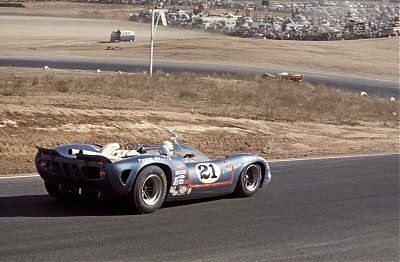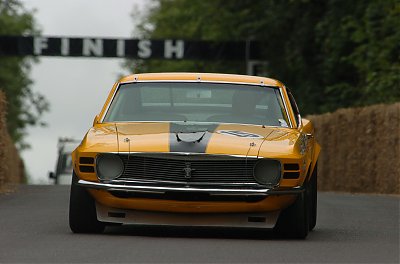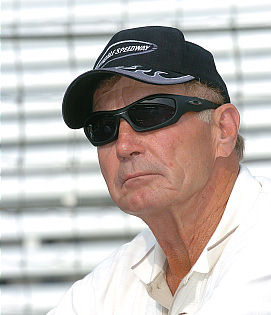The Way It Is/ Parnelli Jones, an American racing legend
by Gordon Kirby On Thursday evening in downtown Long Beach the Road Racing Drivers' Club will host its second annual Long Beach Grand Prix dinner, proceeds to Jeremy Shaw's Team USA scolarship program. Guest of honor for last year's inaugural dinner was Dan Gurney and this year's man of the hour is an equally accomplished legend of the sport--Parnelli Jones. Parnelli was a great all-round driver like Gurney and Mario Andretti, but he was also a rare bird, like Gurney again, who was a successful team owner and car builder. Back in the seventies Vel's Parnelli Jones Racing in Torrance was a cross-town rival of All American Racers building beautiful and fast, race-winning Indy cars.
On Thursday evening in downtown Long Beach the Road Racing Drivers' Club will host its second annual Long Beach Grand Prix dinner, proceeds to Jeremy Shaw's Team USA scolarship program. Guest of honor for last year's inaugural dinner was Dan Gurney and this year's man of the hour is an equally accomplished legend of the sport--Parnelli Jones. Parnelli was a great all-round driver like Gurney and Mario Andretti, but he was also a rare bird, like Gurney again, who was a successful team owner and car builder. Back in the seventies Vel's Parnelli Jones Racing in Torrance was a cross-town rival of All American Racers building beautiful and fast, race-winning Indy cars.
Parnelli started his career driving jalopies at the Orange Show Speedway in San Bernardino and won the IMCA and USAC sprint car championships in 1961 and '62 before winning the Indy 500 in 1963. That was the race where Parnelli beat Jim Clark in the rear-engined Lotus-Ford's Indy debut and there was some wrangling that Jones should have been black-flagged for an oil leak. During a lunch for the winner the day after the 500 Parnelli enhgaged in a scuffle with Eddie Sachs. Sachs and PJ were pals but Sachs decided to debate the matter at the next day's winner's lunch.
"I didn't know anything about the argument over the oil leak until the race was over and it kind of put a little blemish on my win," Parnelli recalls. "But it felt great when I crossed the line. Winning Indianapolis was my goal. It was THE race and to be able to do that was unbelievable. It set you apart from a lot of people.
"I pulled into victory circle and enjoyed my victory and then started hearing all these stories afterwards. I went to bed about twelve or one o'clock and I woke up about two-thirty or three o'clock and went in the bathroom and looked in the mirror to make sure I wasn't dreaming. It was a big thrill.

© LAT USA
"He lost a wheel on the next-to-last lap. After he spun they pushed him and he got going again and I said to him that he probably spun as much because his wheel had come loose. 'No, I spun in your oil,' he said. I said, 'No you didn't Eddie. The track was oily all day long from a bunch of cars, not just mine.' I said something like, 'I think you're full of shit.' And he said the same back to me and we started arguing. I said, 'I oughta bust you in the mouth.' And he said, 'Go ahead.' So I let him have it.
"Eddie was such a great guy and the funny part about it was he had blood coming out of his mouth and a black flag in his hand and a guy took a picture of it. Eddie didn't show up at the banquet that night but this picture of him was in the paper the next day."
Neither man allowed the squabble to affect their friendship.
"Eddie was the Muhammed Ali of racing." Parnelli remarks. "When you got Sachs on a microphone you couldn't get him off. But he was good for racing and we overcame our argument and were friends again after that."
The following year Sachs and Dave MacDonald were killed in a fiery multi-car conflagration on the opening lap of the 500.
"Eddie had a lot of talent," Parnelli says. "He just had no mechanical knowledge. I remember one time Rodger Ward, A.J. Foyt and me were running one, two, three at Trenton. We came up and lapped Sachs in a dirt car and we ran a little longer and pretty soon Sachs caught us and he went back by me, then Foyt and Rodger Ward. Then about forty or fifty laps later here comes Sachs and he came back by all three of us again and won the race. Evidently he reached over and changed the weight jacker and hit it really well and he kicked our asses. But he had no idea!"

© LAT USA
Until 1964, Jones was known only as an oval tracker but in the fall of that year he drove one of Carroll Shelby's Ford V-8-powered 'King Cobra' Cooper Monacos in the pair of fall sports car races at Laguna Seca and Riverside. Parnelli won USAC's stock car championship in 1964 and the series included a few road races. But he was largely a novice at turning right as well as left.
"Shelby called me and wanted me to drive the King Cobra," Parnelli recalls. "I guess Ford put the pressure on him to do that. We had a little tire problem because he was the Goodyear distributor and I was Firestone. But we made a deal to run the best tire and the Firestones were better than the Goodyears."
At Riverside in October of '64 a crowd of more than 80,000 gathered to watch a field of forty cars race in the LA Times GP. Included in the field were Bruce McLaren in the original McLaren-Oldsmobile M1A Can-Am-type car, Jim Clark in a factory Lotus 30, Dan Gurney is his own Ford-powered Lotus 19, A.J. Foyt in John Mecom's Hussein-Chevy, Jim Hall and Roger Penske aboard a pair of Chaparral-Chevies, Bobby Unser in a Lotus 19-Chevy and Richie Ginther driving another Shelby 'King Cobra'. McLaren led for a few laps but hit trouble and Parnelli took over, running away to a memorable victory as he handily beat Penske's Chaparral and Clark's Lotus.
"I think the Firestone tires were one of the reasons that helped me win the race," he adds.
Clearly Parnelli had no trouble adapting to road courses.
"We also ran some road courses when I won the stock car championship in 1964," he says. "I led a lot of those races that Gurney won at Riverside and I won the NASCAR race at Riverside in '67. For some reason or another I took to road racing like a duck to water. It just came real natural for me."
Parnelli also ran four of the six inaugural Can-Am races in the fall of '66, driving a Ford-powered Lola T-70 owned by John Mecom and prepared by George Bignotti. The car and engine were notoriously unreliable but Parnelli showed everyone what he could do at Laguna Seca when he came from the back of the grid to win the second of two, 100-mile heats. That was the last year the race at Laguna was run in two heats. Thereafter it was a single race run over 200 miles.

© LAT USA
"I took off and I was moving up through the crowd pretty good and all of a sudden it started leaking oil so they black-flagged me and I came in. What happened was the Chevy was a little deeper in the oil pan and it rubbed a hole in the pan. So we came in, welded-up the oil pan, put a couple of turns in the rear end and I started the next heat in the back again."
Parnelli drove through the field once more and was up to fourth place after thirty laps behind the pair of Chaparrals driven by Phil Hill and Jim Hall and John Surtees's factory Lola.
"When I caught Surtees he started blocking me. He was coming into the last turn low, rather than wide, and doing the same going up underneath the bridge into the first turn. We were both catching the Chaparrals until he started blocking me. But he kept blocking me and the Chaparrals started getting away from us. So I backed-out and acted like I couldn't pass him so we could both run quicker, and we started gaining on them again."
With thirteen laps to go Parnelli saw his opportunity to pass Surtees.
"He started getting a little braver and a little braver and he stuck it out wide going underneath the bridge. So I stuck it down underneath him and we bumped and he went wide off the corner."
Surtees's car broke its suspension as he bounded off the track while Parnelli pressed on, finally catching and passing both Chaparrals on the second-last lap. After finishing one-two in the first, 100-mile heat Hill and Hall were assured of victory in the combined results while Parnelli was classified twenty-first overall. But he had certainly shown everyone what he could do on a road course.
After retiring from Indy cars Parnelli started racing Trans-Am cars when that series was at its historic height with factory teams from Ford, Chevrolet and Plymouth. He ran five Trans-Am races in 1967 aboard a Mercury Cougar, then ran the full season in '69 and '70 aboard one of Bud Moore's factory Ford Mustangs with George Follmer as his teammate. Parnelli finished second to Mark Donohue and Penske Racing in 1969 and won championship the following year. He won five races and beat Donohue's AMC Javelin to the title by one point.

© LAT USA
Next on Parnelli's agenda was an era as an off-road hero. Driving a variety of Ford trucks built by Bill Stroppe and also by VPJ he won a bunch of off-road races incuding the 1971 and '72 Baja 1,000s.
"What I liked about off-road racing was I didn't have any pressure," Parnelli remarks. "I was going down there doing it for me. In fact, I owned my Bronco. Of course, the first one I won was with Bill Stroppe's truck.
"I enjoyed it because it was like a recreational thing. You go out there and camp out on the pre-runs. When the race starts it's a little different story. I look back, I won the Baja 1,000 in '71 and '72, and I shoulda won in '70, too."
In his rookie year on the off-road epic Parnelli was lured into a mistake.
"Drino Miller had won before and he was one of the cars I had to beat. We got about 250 miles down the course and I pulled into the pits. Of course, back in those days we had no radio communications so you didn't know what was going on and Drino went flying by while I was sitting in the pits.
"Well, it wasn't Drino. He had a pre-runner that looked like Drino's race car. His crew was down there and they went storming by and went down the road and pulled into some trees.
"I went back out and was trying to catch--nothing! I was looking for the dust and driving over my head and I got off the road and bent the rear end housing. That cost us the race. So I knew that the next year I just had to keep my car together and be a little smarter. That incident helped me make a decision to slow-down a bit, I guess.
"Stroppe was the biggest part of it," Parnelli adds. "I won the first 500 without ever having pre-run it. But Stroppe had, so he knew where to go. It also might've helped me not knowing the road because if you know the road you drive a little harder. I about slipped her off the road once but that was all and we won the 500.
"The record was sixteen hours and something and I did it in fourteen hours and fifty-nine minutes. That's still the quickest time from Ensenada to La Paz, except it's different now because they have to criss-cross the road and I had a straight shot. Anyway, I had a lot fun doing that. It was enjoyable. I didn't make any money but it was enjoyable."
Parnelli's last race was the Baja 1,000 in 1974.
"That was the last race I drove. Stroppe had Alzheimer's at that time so he put this other kid in for the 1,000. I got down to the Bay of Los Angeles and we were leading class seven by about forty-five minutes and running third or fourth overall. So I asked this kid after the pitstop, 'Well, what do you want to do? Go for the class seven win? Or go for the overall?'
"He said let's go for it and I got about twenty miles down the road just before sunset and rolled the sonofabitch into a ball. Luckily, it landed on its wheels and we got it to the finish. The roll cage was bent and we got it to San Juanico and another driver took over and he wound-up finishing the race.
"After that I was thinking if somebody got hurt out there at night, you'd be dead. You were in an area where it's not easy to get to. So I decided I would go down there and pre-run because I enjoyed that. I still have my pre-runner. I've kept it updated. I call it my pacifier. I go out and slide a few turns and stop and have a beer."
Who does Parnelli rate as the best Indy drivers from his era?
"It was Hurtubise, Foyt, Sachs and me who you had to beat most of the time," PJ says. "And of course, Don Branson in the sprint cars which were shorter races. Later it was Mario, Bobby and Al, Rutherford and Roger McCluskey.
"Hurtubise and Foyt and I were a little younger and a little tougher and stronger than the older guys like Sachs and Rodger Ward and Branson. But about that time they got power steering and boy, those guys really came back to life! Power steering was a big, big improvement. You could drive like it was qualifying all day long. Same with the stock cars. These guys today don't appreciate we used to run those stock cars and Trans-Am cars back in those days without any power steering. You had to be in good shape to run those cars hard for 200 miles."
Parnelli famously turned down an offer from Colin Chapman to drive for the Lotus F1 team because he wasn't interested in being number two to Jim Clark. Still, Parnelli rates Clark, Jackie Stewart and Dan Gurney as the best all-round racers he's ever seen.
"Jimmy Clark and Stewart were probably the best. So was Denis Hulme. I had a lot of respect for those guys. Dan Gurney was a hell of a race driver. I've had a lot of races against Dan and been teammates with him. He's a great guy and a great teammate. George Follmer was also a great teammate in the Trans-Am. I got along with him great. And of course, Mark Donohue was also a great race driver."
Of today's drivers Parnelli is most impressed with Jimmie Johnson and the fine working relationship Johnson enjoys with crew chief Chad Knaus.
"You have to click with the chief mechanic and Jimmie Johnson is a perfect example," PJ observes. "In my opinion, Jimmie Johnson has the greatest patience of any driver I've ever seen. He's an Al Unser Sr. He's phenomenal and he works so well with his chief mechanic. He can tell him what the car is doing.
"I think that's really the outstanding thing in racing when a driver can really communicate well with his mechanic and that guy understands what the driver needs when he says something so that he makes the right corrections and by the time the end of the race comes the car is in pretty good shape."
You may not have the pleasure of joining us for dinner with Parnelli in Long Beach on Thursday night. But I hope you've enjoyed a taste of the man's personality, many accomplishments and vast racing knowledge.
Auto Racing ~ Gordon Kirby
Copyright 2010 ~ All Rights Reserved
Copyright 2010 ~ All Rights Reserved
Top of Page